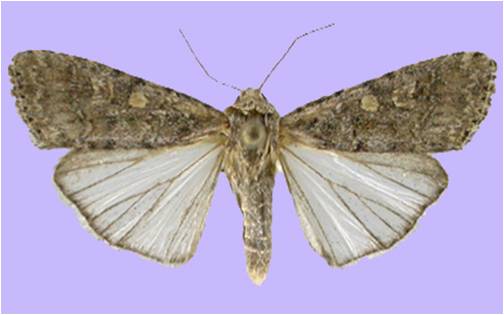3. Beet Armyworm: Spodoptera exigua (Noctuidae: Lepidoptera)
Distribution and status: Europe, South Africa, America and the Orient. In India, USA, Canada and other countries, it has been recorded as a minor pest of lucerne (Medicago sativa) and hence, is also known as the lucerne caterpillar
Host range: Specific pest of jute and is the most destructive At one time, it was a major pest of indigo (Indigofera errecta)and hence also called indigo caterpillar. Also; it is a minor pest of chillies, onion, binjal, sweet pepper, gram, linseed, lentil, cabbage, maize, cotton, safflower (Carthamus tinctorius), sunflower, etc.
Bionomics
The moths have dark spotted fore wings and white hind wings. They are nocturnal and remain hidden under various shrubs in the day time. The colour of larvae depends on the crop on which they feed. The pest passes winter as a pupa, which is enclosed in webbings, forming a rough pupal cocoon. Few emerge as moths in February and majority during beginning of the monsoon. A female lays up to 200 spherical eggs in clusters covered with buff hairs. The eggs hatch in 1-3 days and the young caterpillars start feeding in groups. Larval period 15-20, pupa period 5-7 days and the life cycle 30 days. From November onwards, the pest hibernates in the pupal stage. During the active season, a number of generations are completed. |
Damage symptoms
The damaged crop, on which larvae have fed, gives a webbed appearance. The older caterpillars, which feed in the morning and evening, have a voracious appetite and strip off quite large patches on the foliage. However, the young jute plants, less than two months of age, suffer the most. The early sown capsularis varieties suffer greater losses than those sown later.
Management
- Collect and destroy egg masses and· the caterpillars which are feeding within the webs.
- Spray 2.0 L endosulfan 35 EC in 2000 L of water per ha.
|

